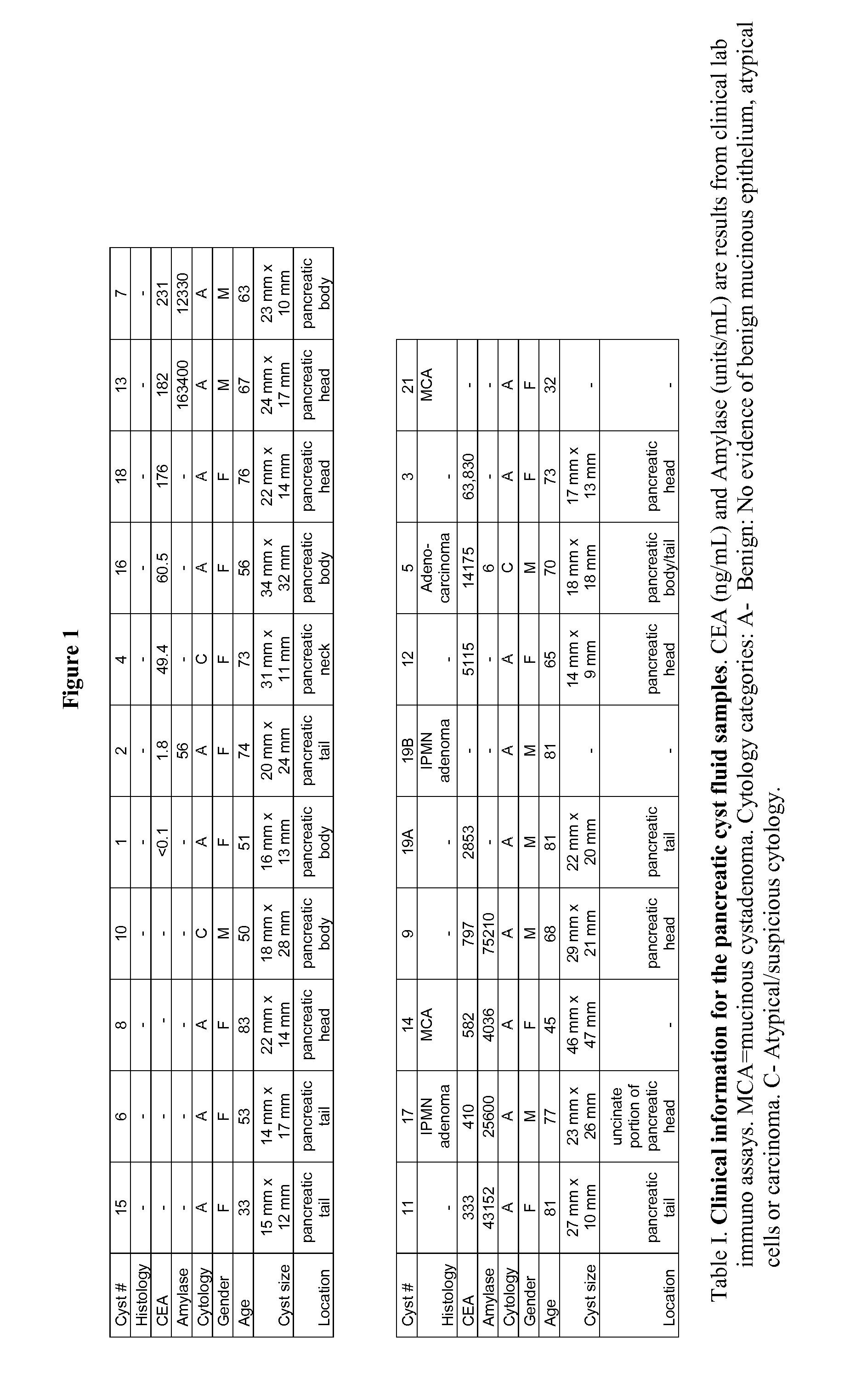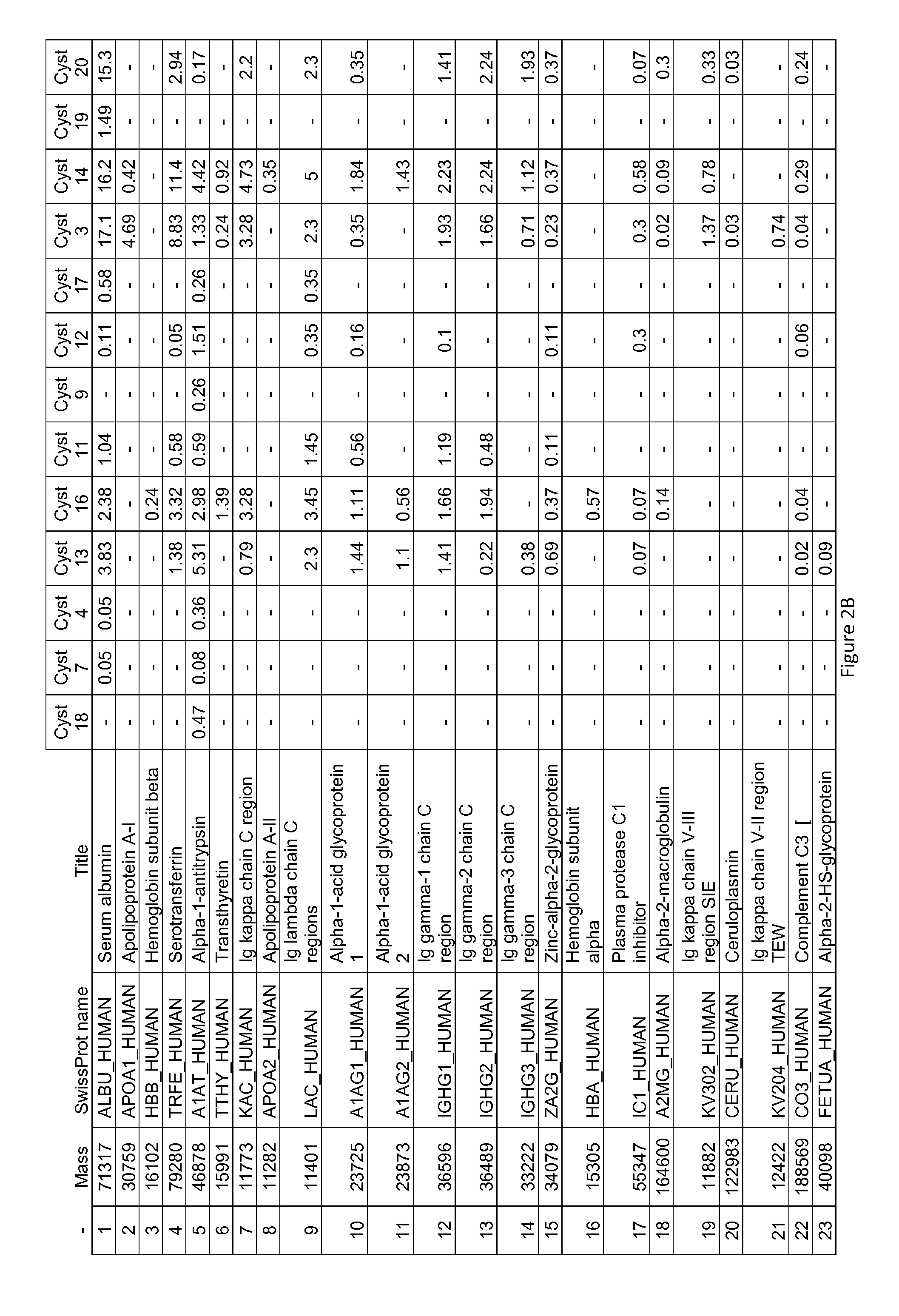Mucin 5B as a Pancreatic Cyst Fluid Specific Biomarker for Accurate Diagnosis of Mucinous Cysts and Other Markers Useful for Detection of Pancreatic Malignancy
a pancreatic cyst and fluid specific technology, applied in the field of oncology and proteomic analysis, can solve the problems of increasing and achieve the effect of increasing or reducing the risk of pancreatic cancer
- Summary
- Abstract
- Description
- Claims
- Application Information
AI Technical Summary
Benefits of technology
Problems solved by technology
Method used
Image
Examples
example i
Proteomic Analysis of Pancreatic Cancer Fluids
[0109]The following materials and methods are provided to facilitate the practice of the present invention.
[0110]Sample Acquisition.
[0111]Aliquots of cyst fluid that were used for this project were obtained from materials that were aspirated for clinical purposes. The study was approved by the Institutional Review Board of the Fox Chase Cancer Center. EUS-FNA (14) was performed under conscious sedation using a linear echoendoscope. When a lesion was identified, EUS-FNA was performed with a 22 or 19-gauge needle through either a transduodenal or transgastric approach, depending on the location of the lesion within the pancreas. The highest priority was given to procuring a volume of fluid that was adequate to perform the necessary clinically indicated diagnostic assays (e.g., cytology, CEA in ng / mL, Mayo Medical Laboratories, code #84074), amylase (in units / L, Mayo Medical Laboratories, code #5079). As little as 40 μL of cyst fluids per p...
example 2
Xenograft Model of Pancreatic Cancer and Pancreatic Cyst Fluid Secretion
[0136]The use of clinical samples for studying the biology of pancreatic cyst to cancer is difficult because of inability to obtain time course material in most instances, and because most invasive techniques of laboratory investigation cannot be used on patients. A mouse model, if valid and available, can accelerate pancreatic cancer research. For example, mouse stroma cells infiltrating the tumor and supports the tumor growth can be marked with Green Fluorescence Protein by using a GFP transgenic mouse as the host of the xenograft.
[0137]In the laboratory of Dr. Repasky, about 33% of pancreatic tumors engraftment resulted in successful tumor propagation for three passages for both adenocarcinomas and neuroendocrine tumors (38, 39). These xenograft tissues contain complex cell types from both cancer and stroma. The cancer cells form glands that hold secretions similar to what is seen in the parent tumors. We obt...
example 3
[0140]As mentioned above, pancreatic cancer kills about 40,000 patients each year. Absent the present discovery, there is no early detection. Current diagnosis is neither completely accurate nor confident, with both unavoidable false positives and false negatives. There are several types of pancreatic cancer with different biology and outcome. Some rarer varieties are less aggressive than adenocarcinoma which comprises 85% of pancreatic cancer arising in the pancreatic duct. Not all adenocarcinoma are observed to originate from a cyst. While most pancreatic cysts are benign in the short term, there is no certainty that the cyst which appears benign today will still be benign a few years later. Thus all pancreatic cyst patients are followed periodically with more scanning
[0141]A patient suspected of having a mucinous pancreatic cyst is often referred for surgical resection because of significant risk that cancer is present. Liquid from the cyst is collected by a needle that goes thro...
PUM
 Login to View More
Login to View More Abstract
Description
Claims
Application Information
 Login to View More
Login to View More - Generate Ideas
- Intellectual Property
- Life Sciences
- Materials
- Tech Scout
- Unparalleled Data Quality
- Higher Quality Content
- 60% Fewer Hallucinations
Browse by: Latest US Patents, China's latest patents, Technical Efficacy Thesaurus, Application Domain, Technology Topic, Popular Technical Reports.
© 2025 PatSnap. All rights reserved.Legal|Privacy policy|Modern Slavery Act Transparency Statement|Sitemap|About US| Contact US: help@patsnap.com



